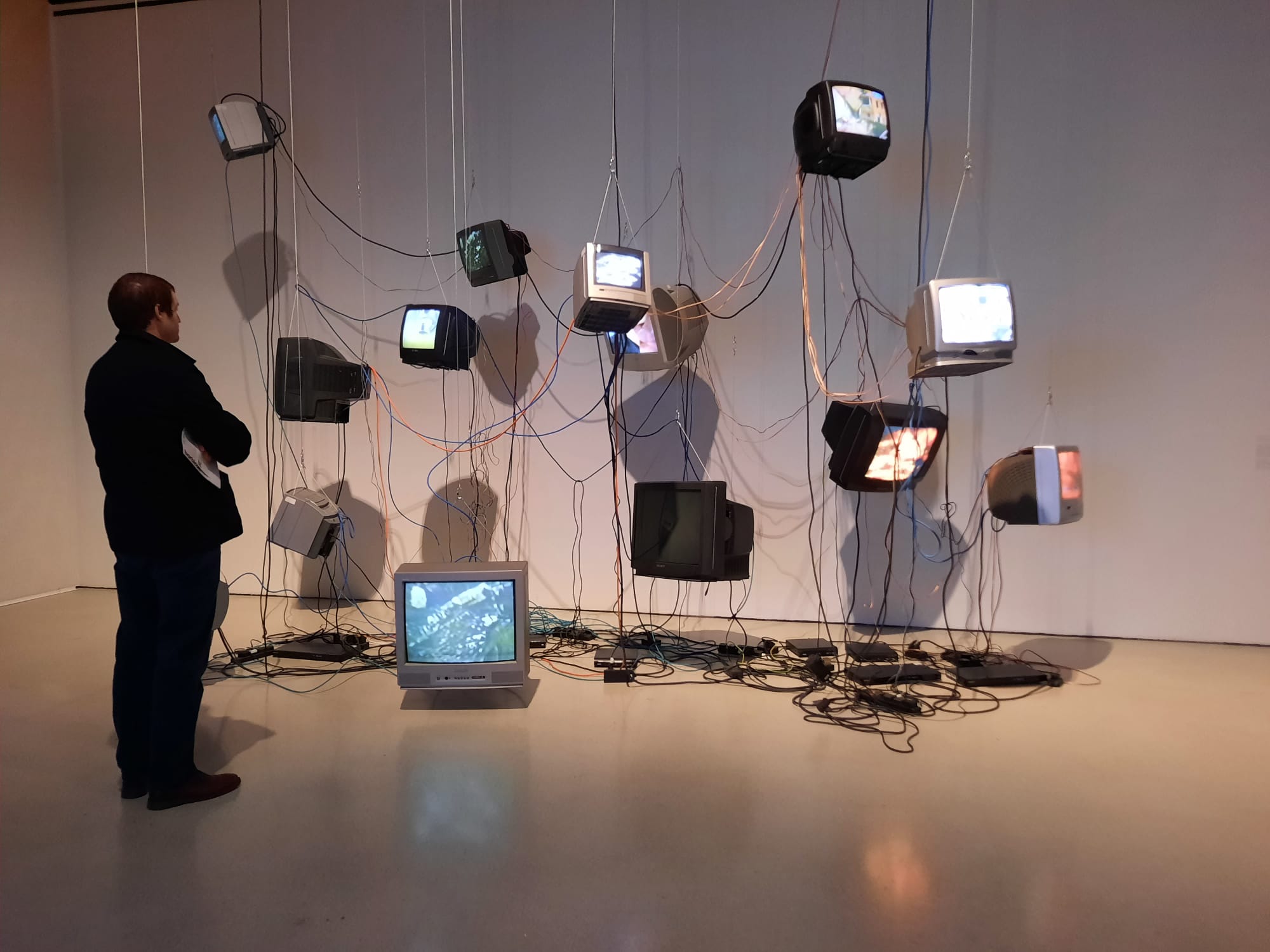Carolee Schneemann: Body Politics – Barbican, London
A review of Carolee Schneemann: Body Politics, on for a few more weeks at the Barbican. Schneemann’s politically engaged work, often focused on her body and sexuality, still appears radical to audiences decades after its creation.
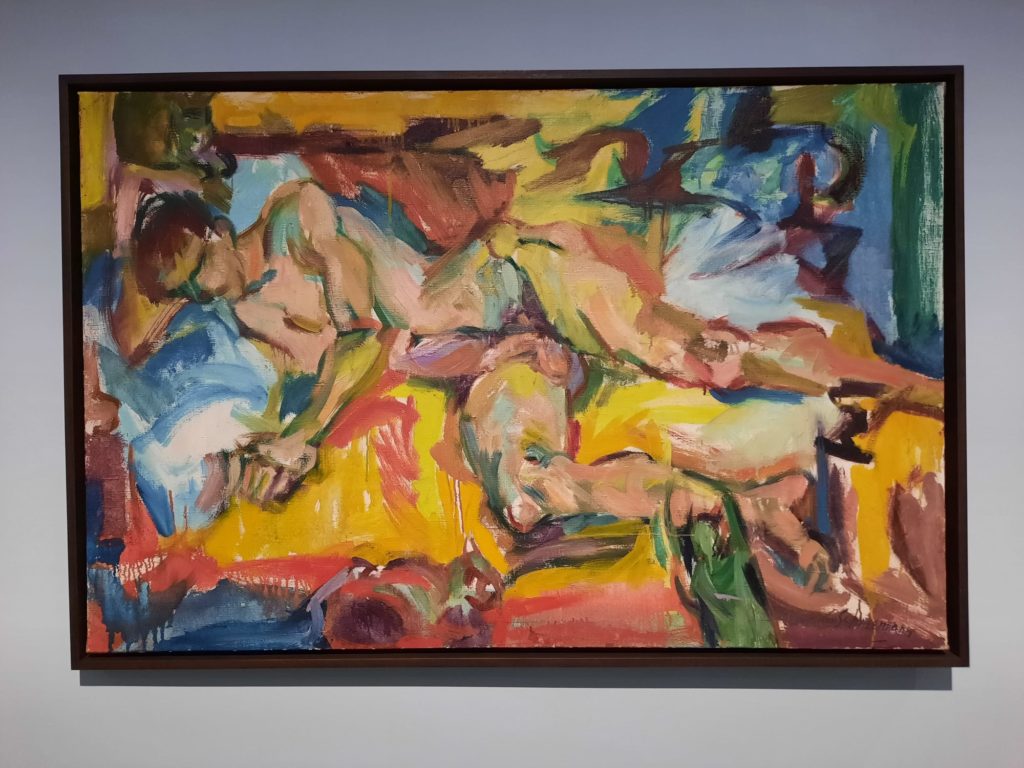
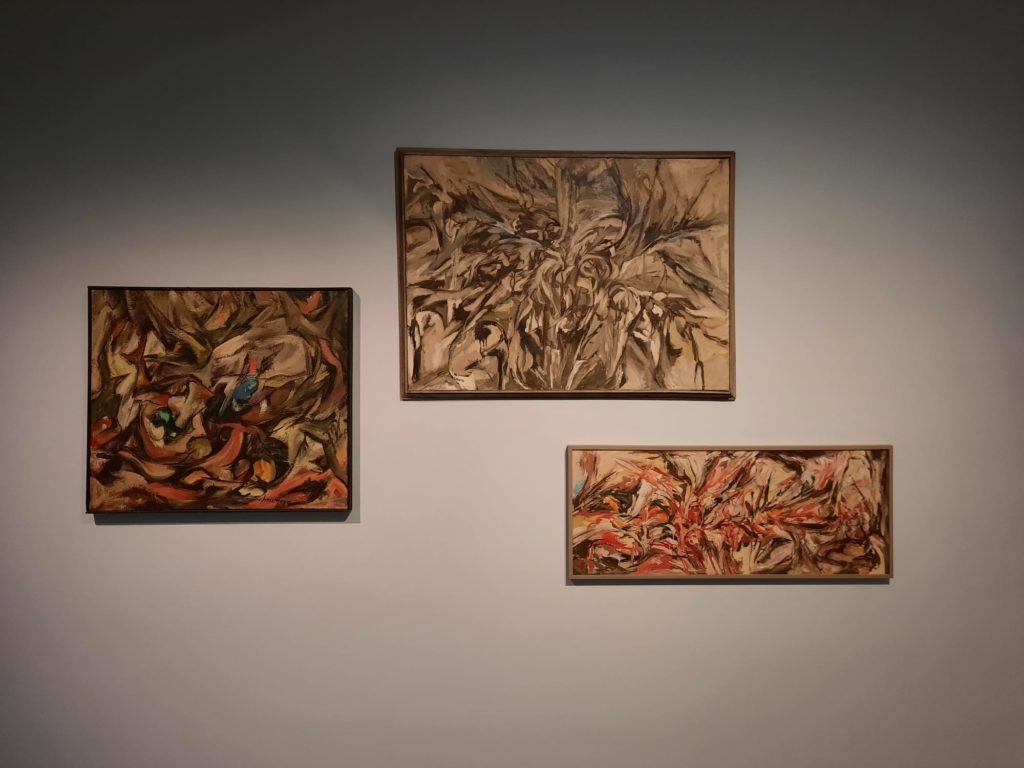
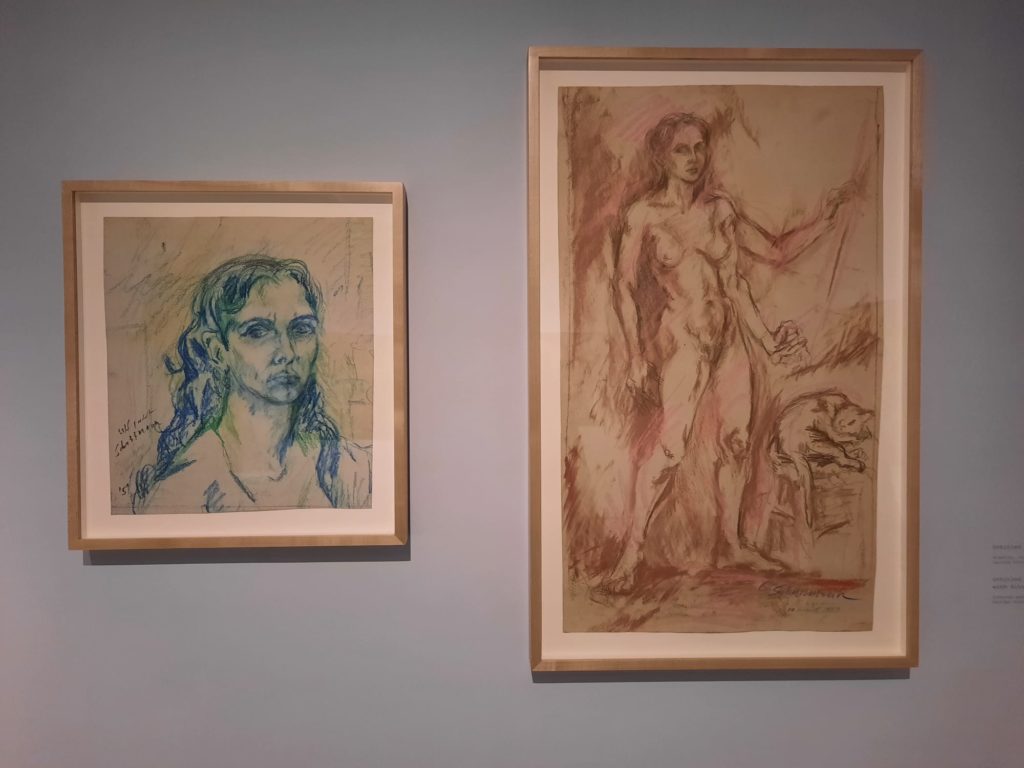
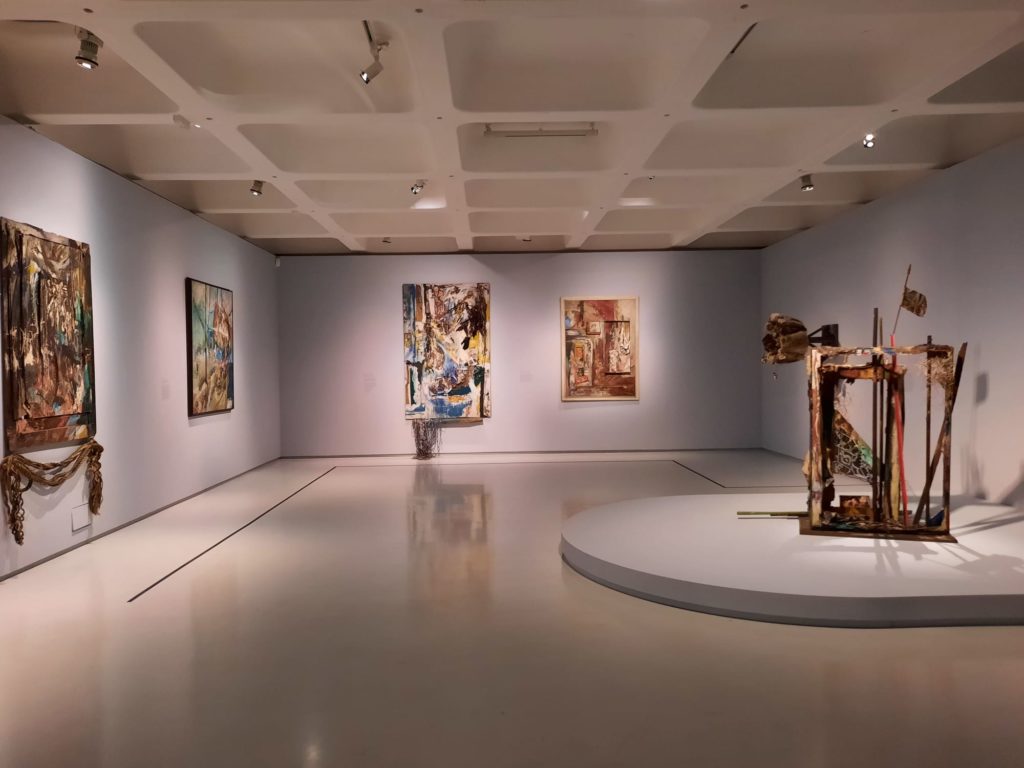
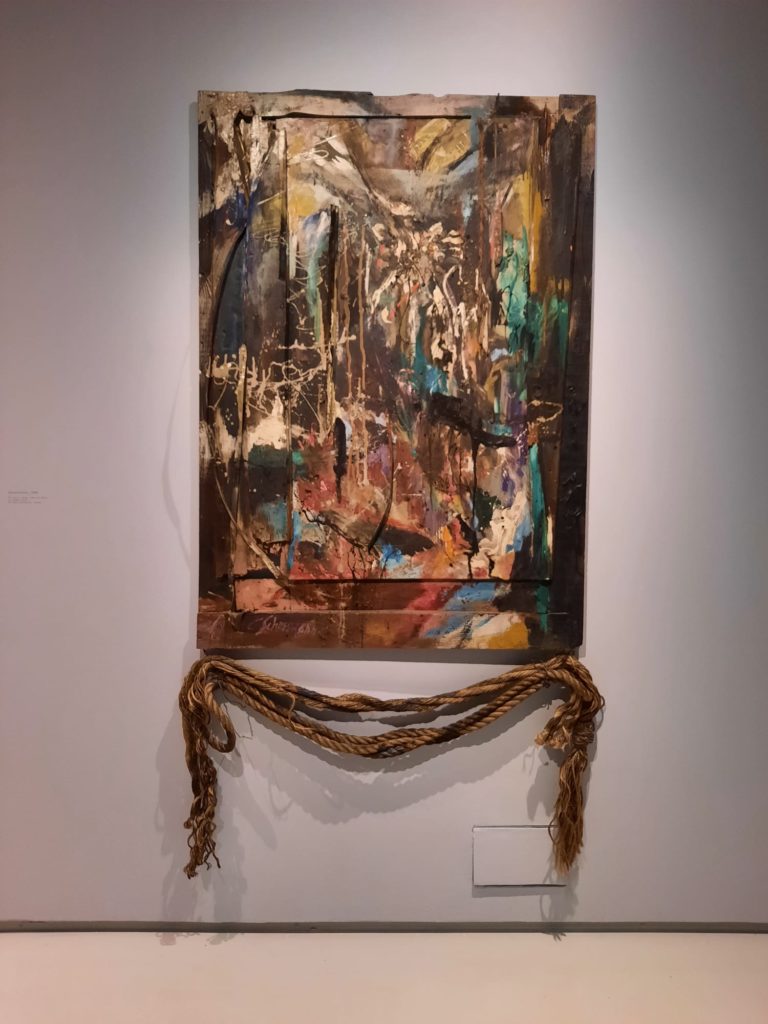
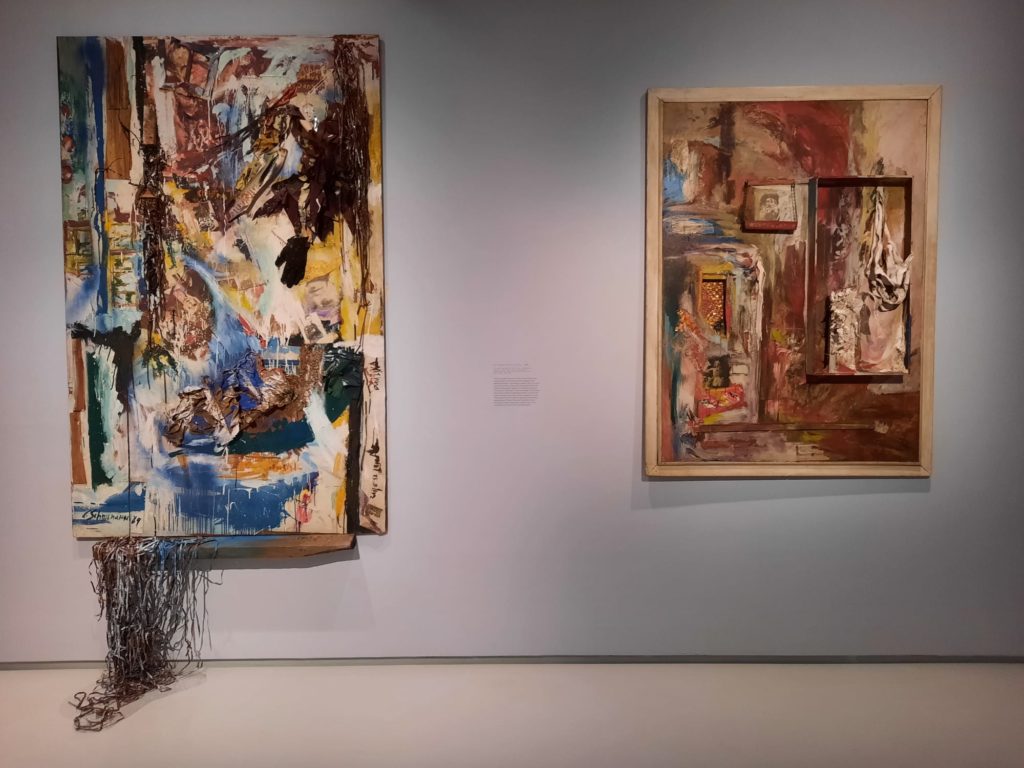
Female/Feminist Artists: Under The Spotlight
It seems to me like female artists are undergoing something of a rebalancing at the moment in London institutions. I don’t want to say rehabilitation, because if these artists have been overlooked, it’s generally nothing to do directly with them and their work. More the ongoing bias towards male artists. You know, that old chestnut. The redress, or rebalancing, or whatever you want to call it, is in some cases a very conscious decision. A gallery guide I picked up recently at the Tate said about an exhibition that it “is one of several exhibitions at Tate which show how women artists have revolutionised modern sculpture”.
Carolee Schneemann: Body Politics feels more in-keeping with the Barbican’s regular programming than this statement. Even just in what we’ve seen there over the past couple of years, they have a consistent focus on interesting figures in the art world who are not necessarily obvious choices for an exhibition. Isamu Noguchi or Michael Clark, for instance. Granted, these are both men. There’s been a bit more programming from women artists in the Barbican’s Curve space, like Toyin Ojih Odutola, Shilpa Gupta or Claudia Andujar. So perhaps after all there’s some effort required to balance out the use of the gallery spaces. But in any case I think what I said about it feeling like a typical Barbican sort of exhibition still stands.
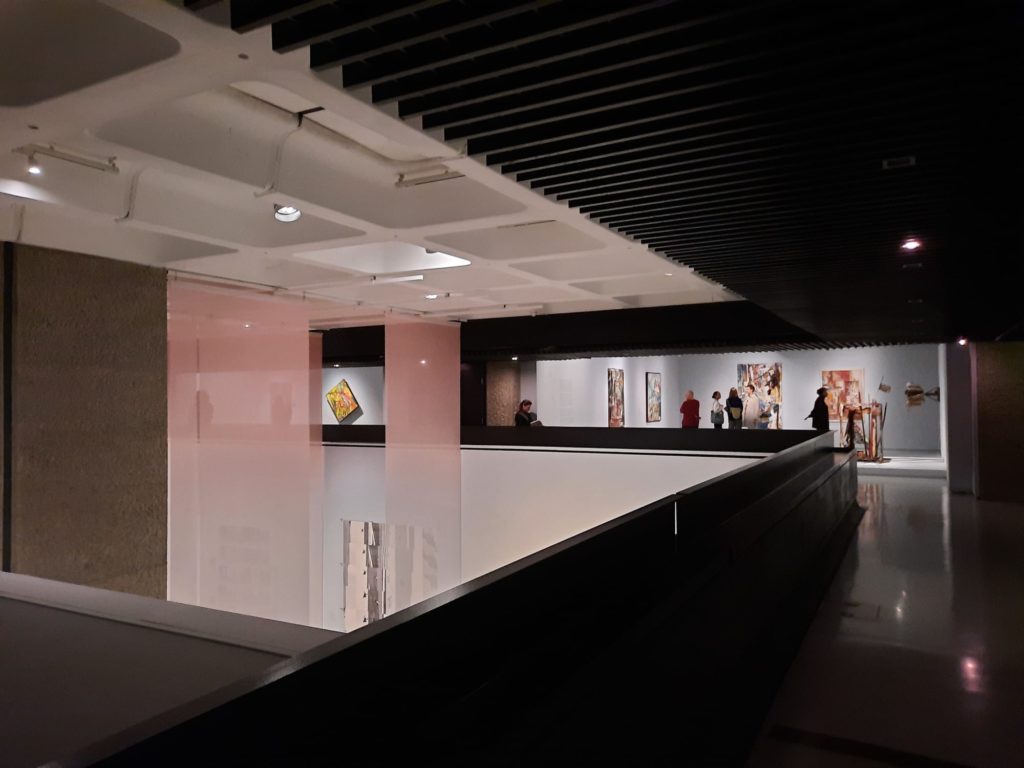
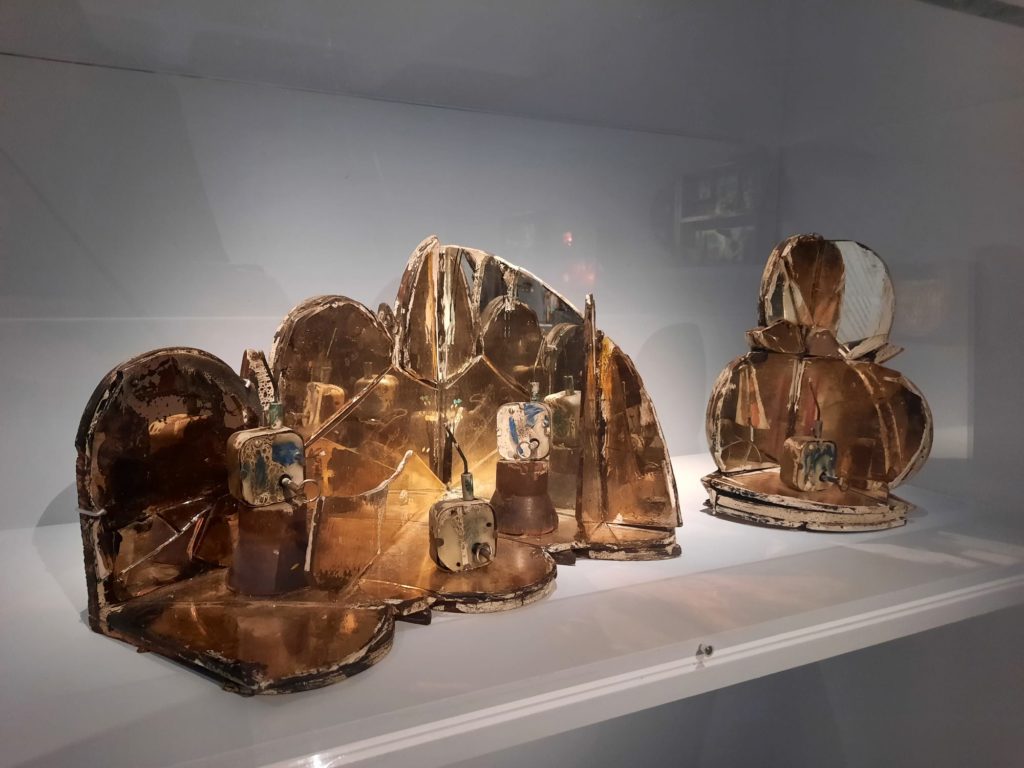
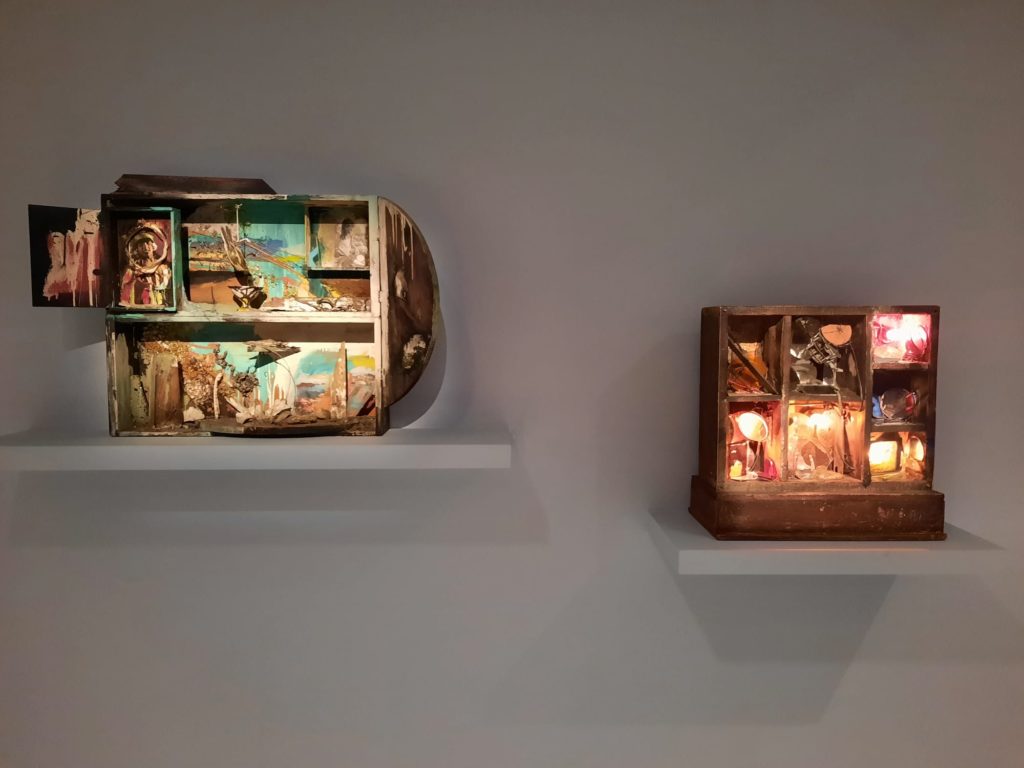
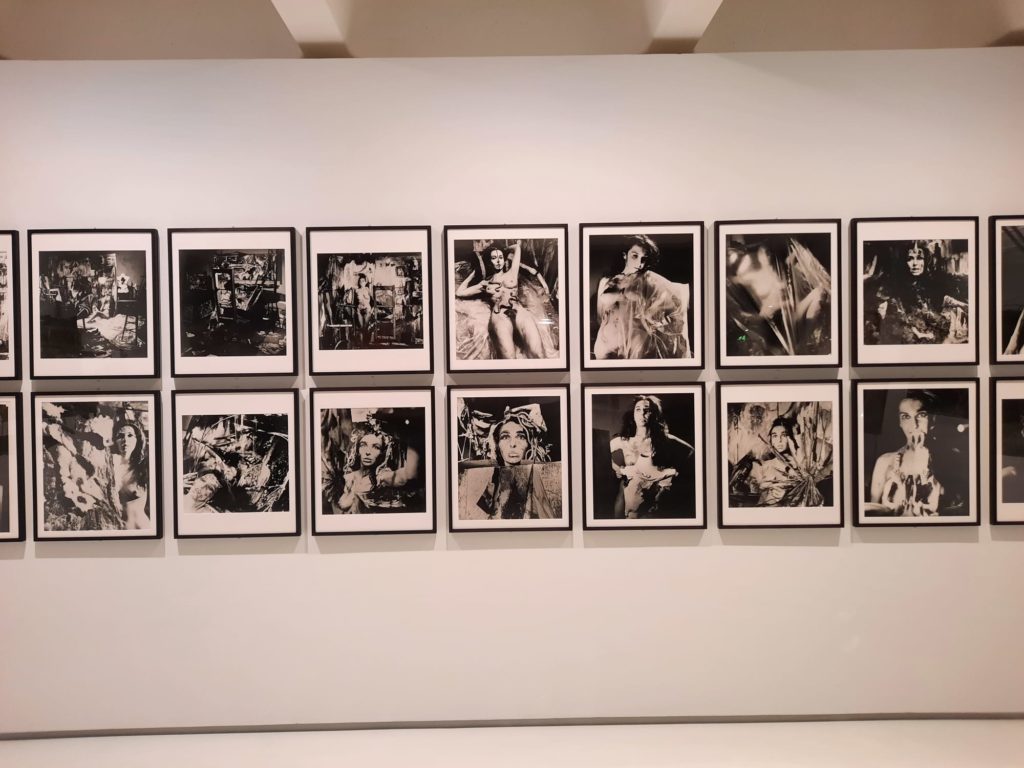
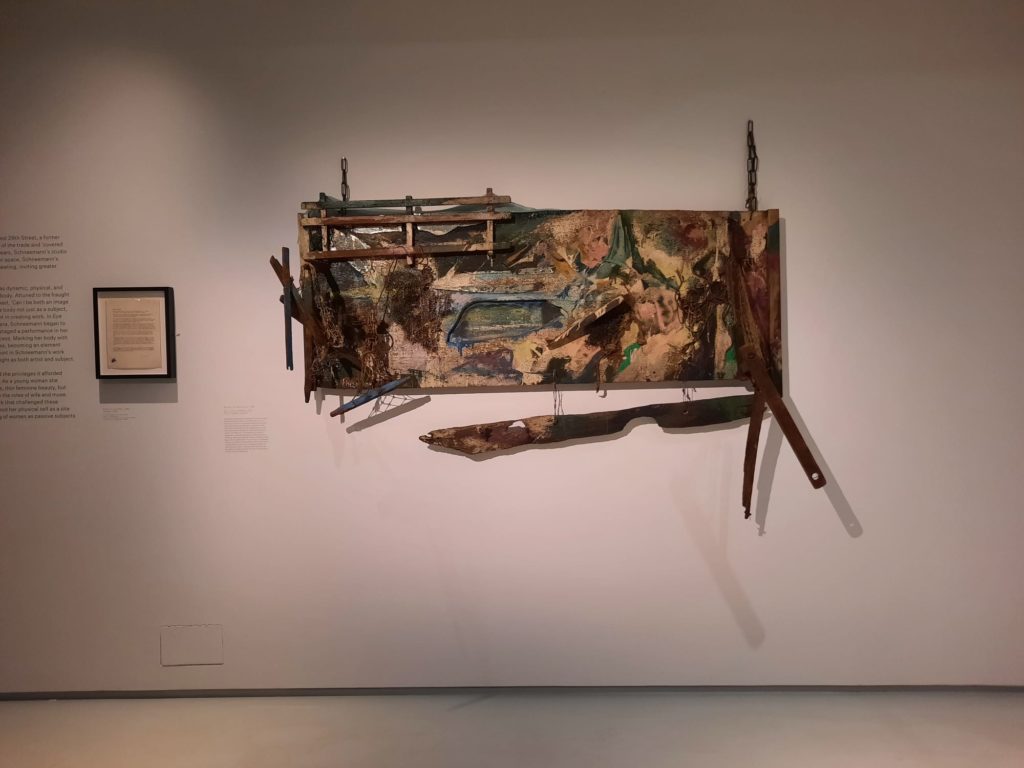

Carolee Schneemann: Body Politics
So who is this artist anyway? Well, Carolee Schneemann was an American artist, born in 1939 in Fox Chase, Pennsylvania. She had a typical rural upbringing with parents who encouraged her to become a typist. She won a full scholarship to study at Bard College in New York, but was ejected for ‘moral turpitude’: depicting her own naked body due to lack of life models. Luckily Schneemann was able to transfer to Columbia University and the New School and retain her scholarship. She took inspiration from artists old and new, including Cézanne who she initially mistook for a woman due to the ‘anne’ at the end of his name.
Schneemann’s art soon began to break free from the confines of the canvas. To begin with this took the form of artworks with objects protruding beyond the stretchers. Then three dimensional works reusing old canvases. Kinetic works. Assemblages. Then incorporating temporality and the movement of her own body into her art. Some of her works she subjected to controlled burning. There were documented performances where she interacted with her artworks, her body marked with paint. This was, after all, the period of ‘happenings’, and Schneemann was there at the forefront of nascent performance art, using dance, props, film and more to create and capture her art.
Schneemann lived for decades in New Paltz in Upstate New York. After the end of one long-term relationship she sought a clean break and moved to London for a couple of years. She didn’t find the local art scene entirely welcoming, but had a creative and productive period nonetheless. She moved back to her Upstate New York home after this interlude, and after many more years, many more artworks and a long battle with cancer, died in 2019
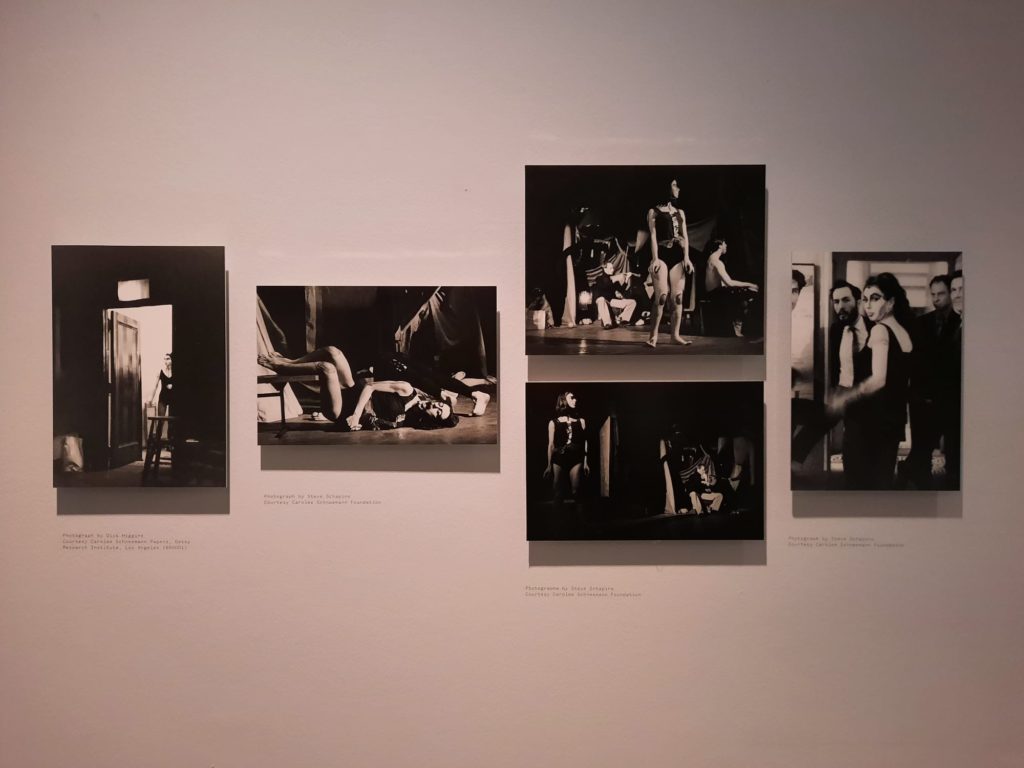
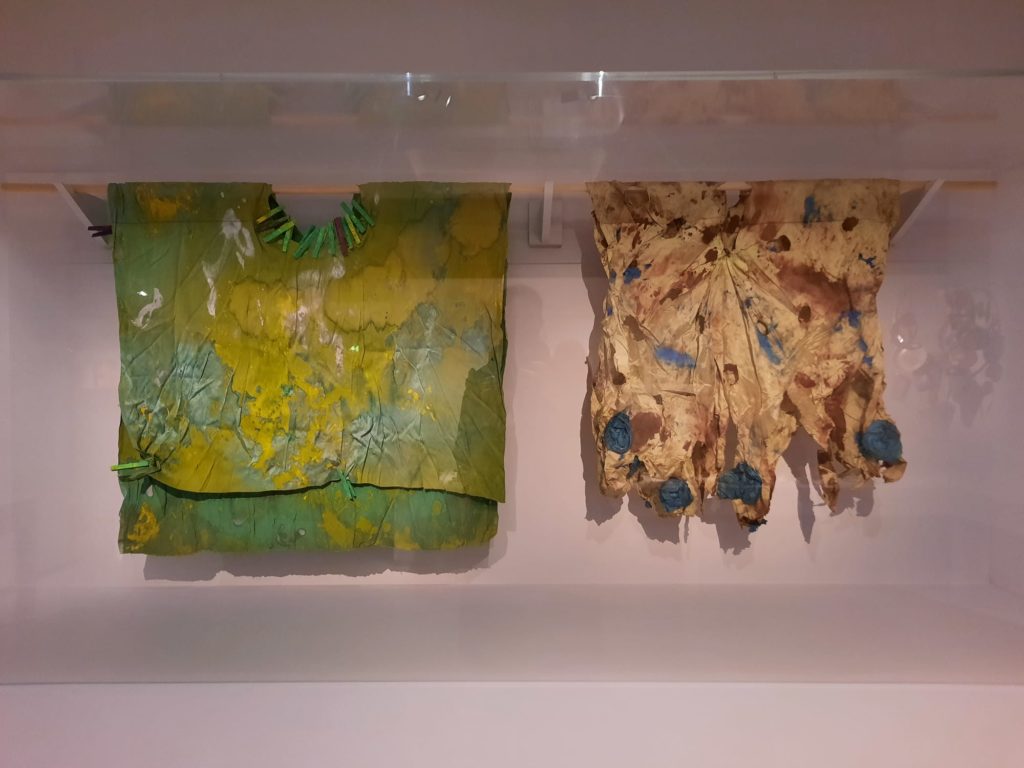
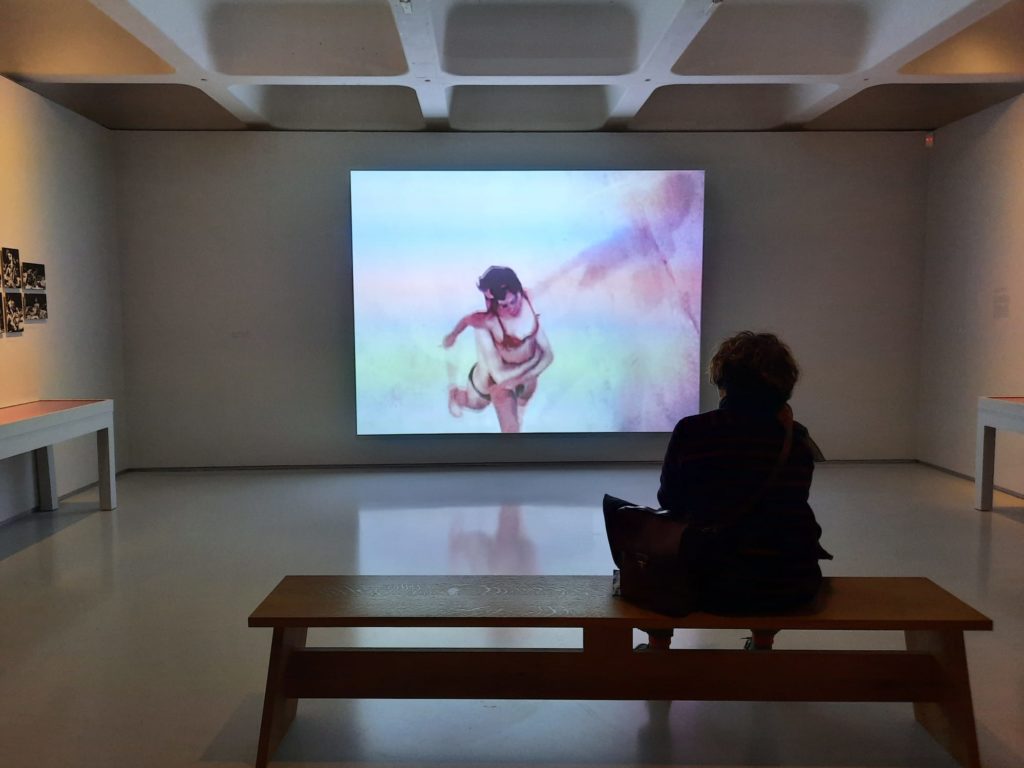
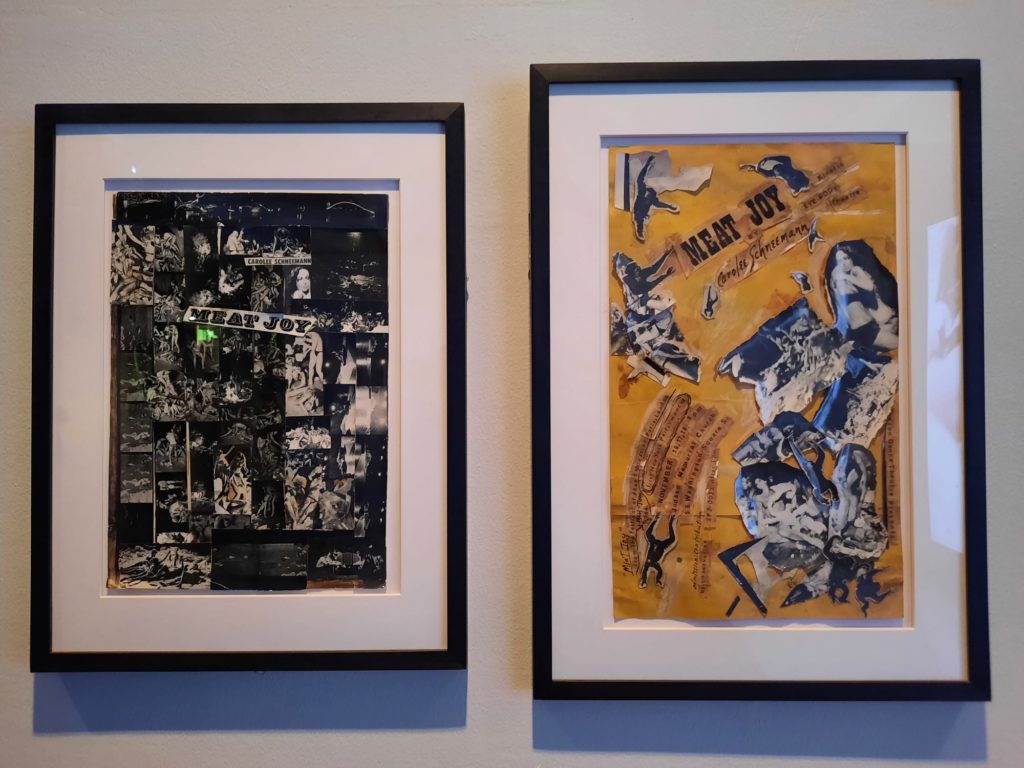
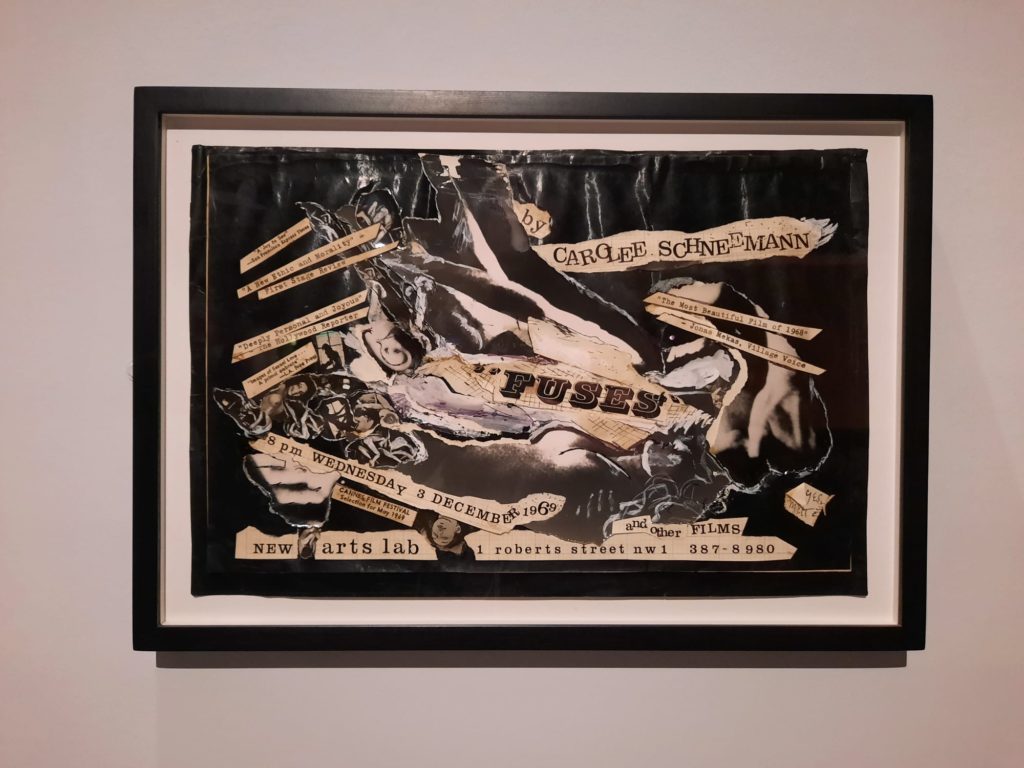
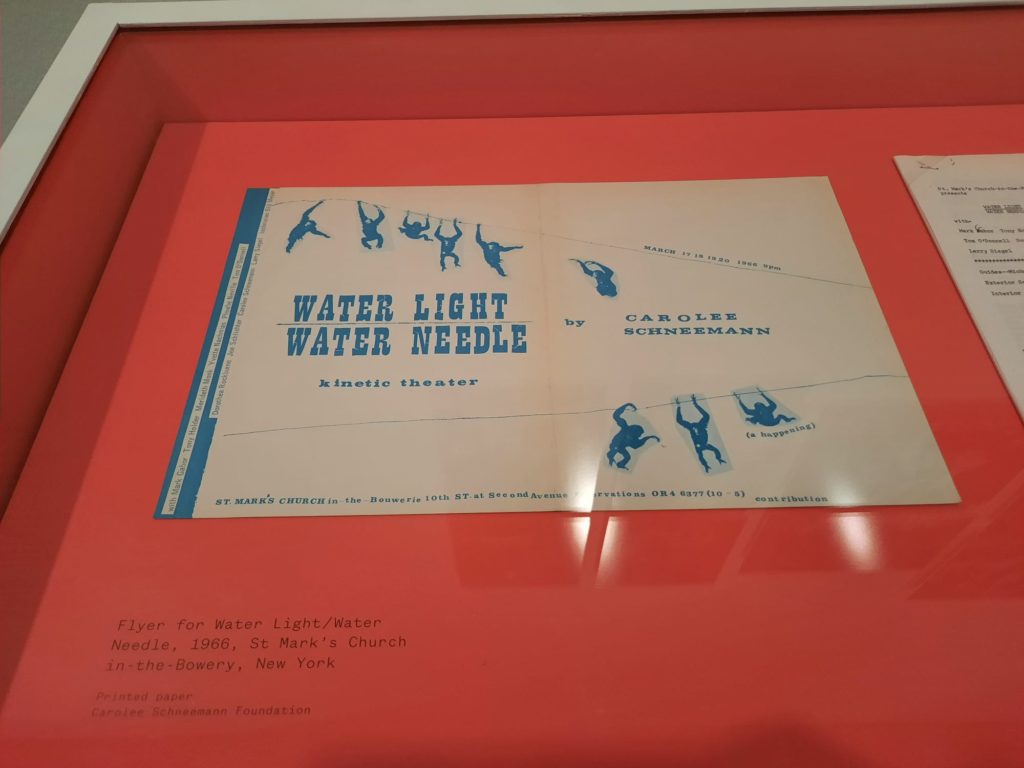
Body. Politics.
The Barbican’s exhibition is a full-scale retrospective. It presents Schneemann as a groundbreaking and transcendant artist, one who used her art and herself to address urgent issues, “from sexual expression and the objectification of women to human suffering.” The layout, however, is a traditional chronological format. We start with Schneemann’s early works at art school.
We see very quickly her refusal to accept social or artistic confines. Her art very literally breaks free within a room or two, and she doesn’t look back. A few kinetic works document this clearly. You have to time your visit well as they don’t move all the time. And some of them are not immediately apparent as kinetic works. An exception is Fur Wheel, a work from the Carolee Schneemann Foundation which is deliciously tactile and looks like it wants to make a sound even at first glance. It’s definitely worth enquiring when this one is next meant to come to life and come back to see it.
Once her art is free of the confines of the canvas, we see a truly creative mind at work. She seems to have little interest in rules, and to have constantly forged her own path. That isn’t to say that she didn’t interact and exchange ideas with other artists. Her assemblages, for instance, have a clear and acknowledged debt to Joseph Cornell. I don’t recall him lighting his on fire, however.
The ‘happenings’ and performance art were often group efforts as well. Several early works were devised as part of the Judson Dance Theater in New York City. As we move through the exhibition we see how this semi-improvised dance troupe connects to later works by Schneemann such as Meat Joy, where performers tangled on stage in a literal pile of meat. Until the police came to shut them down, that is!
Later works in the exhibition continue this tendency towards using her own (often naked) body in her art. There is also a very overt political activism, for instance in speaking out about the Vietnam War, reflecting on terrorism, and commemorating friends lost to the AIDS Epidemic. As her fight against cancer intensified her art reflected this personal struggle, with reflections on illness, treatment, hope and the pathologising of women and women’s bodies.
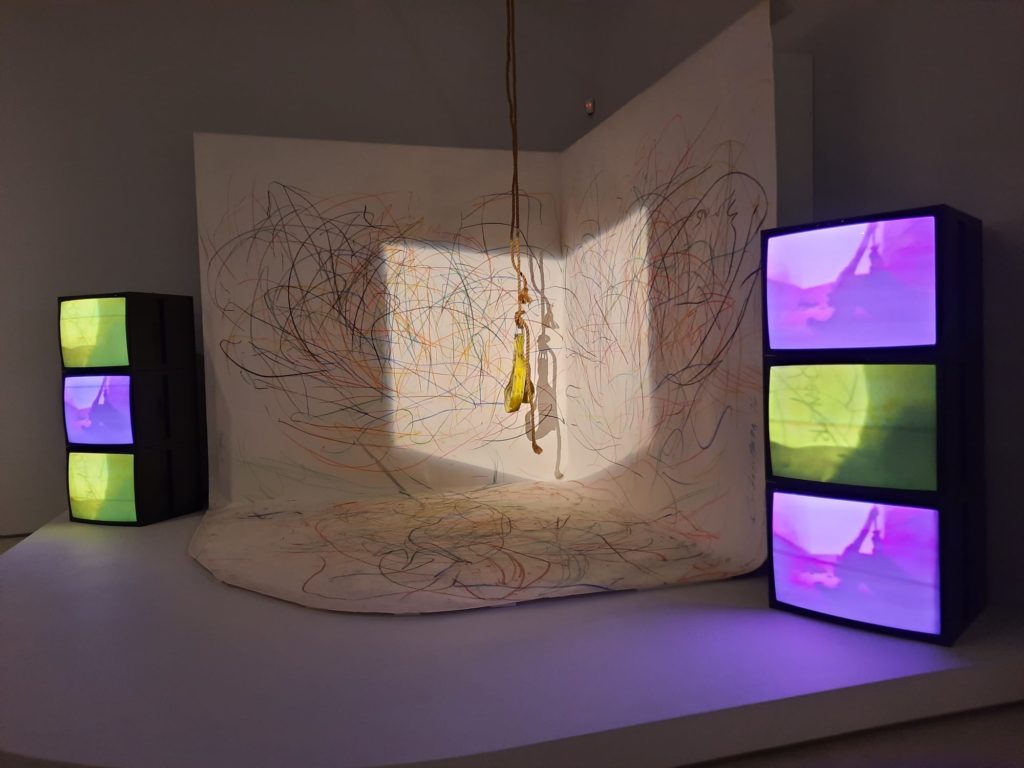
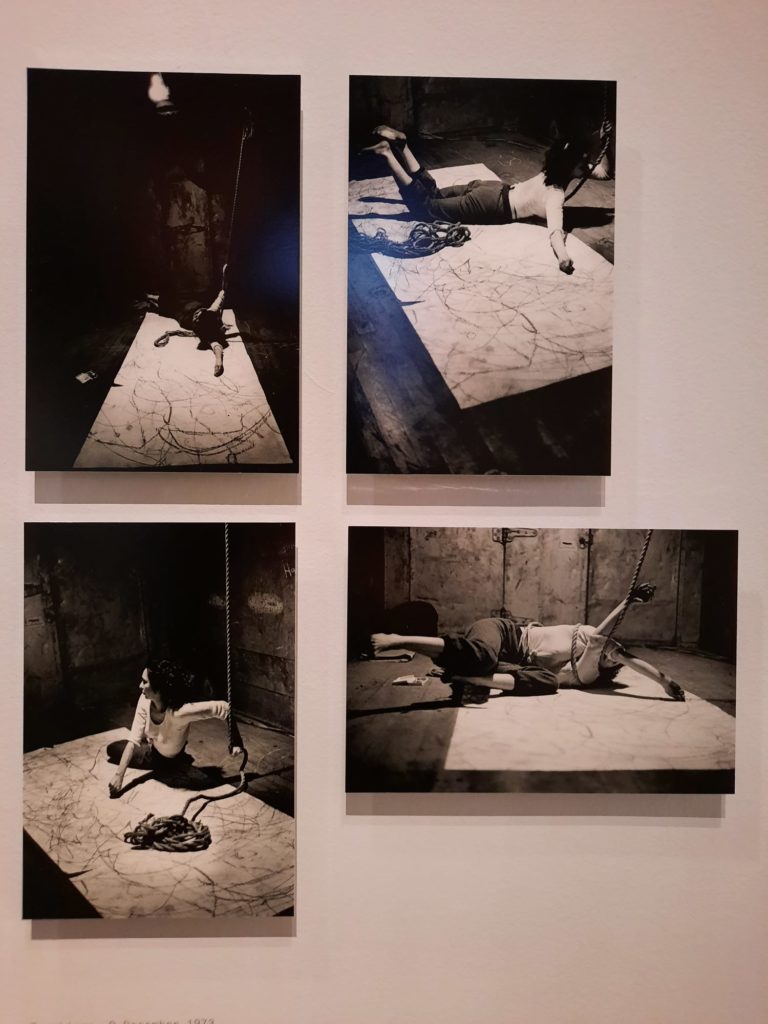
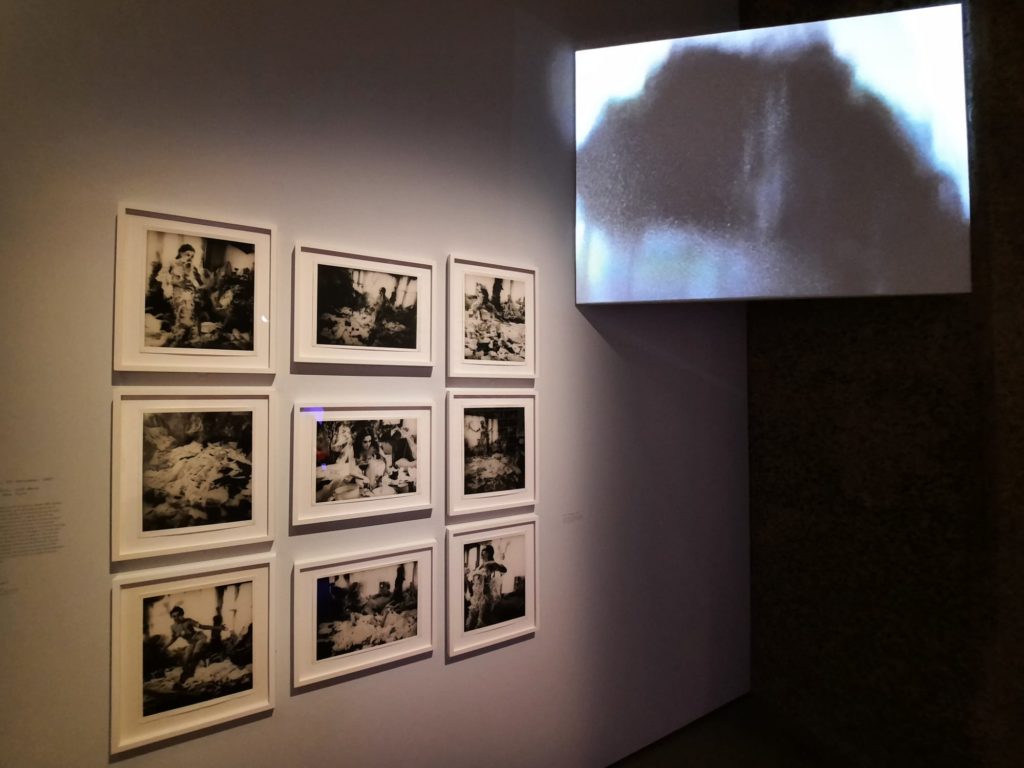
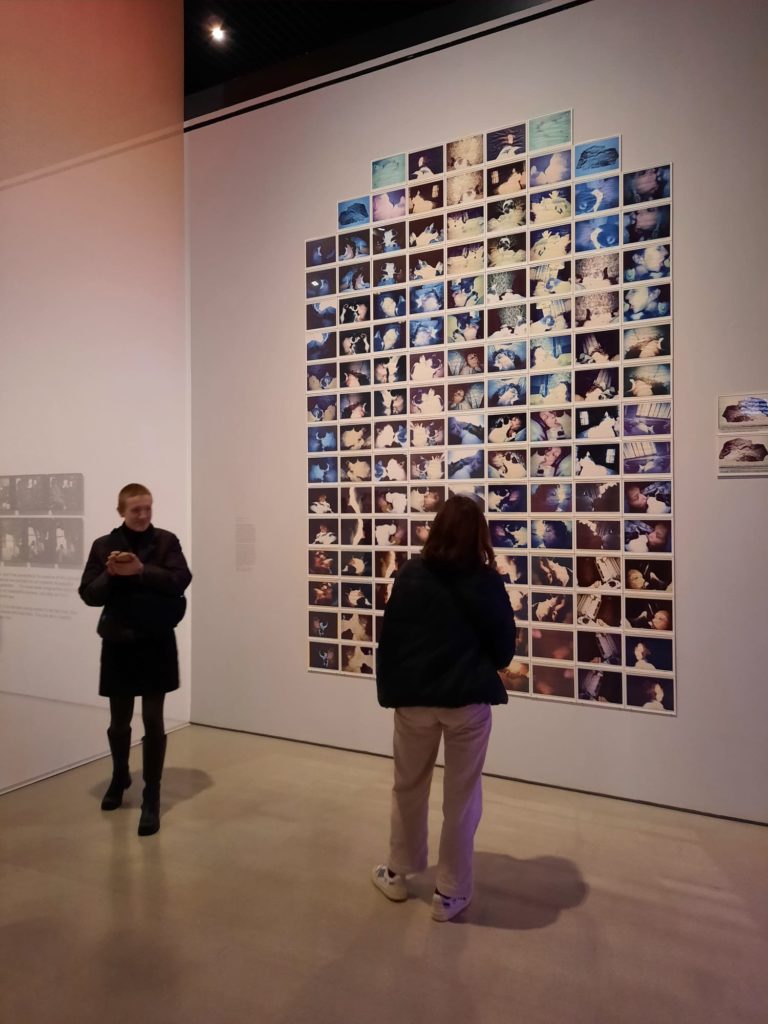
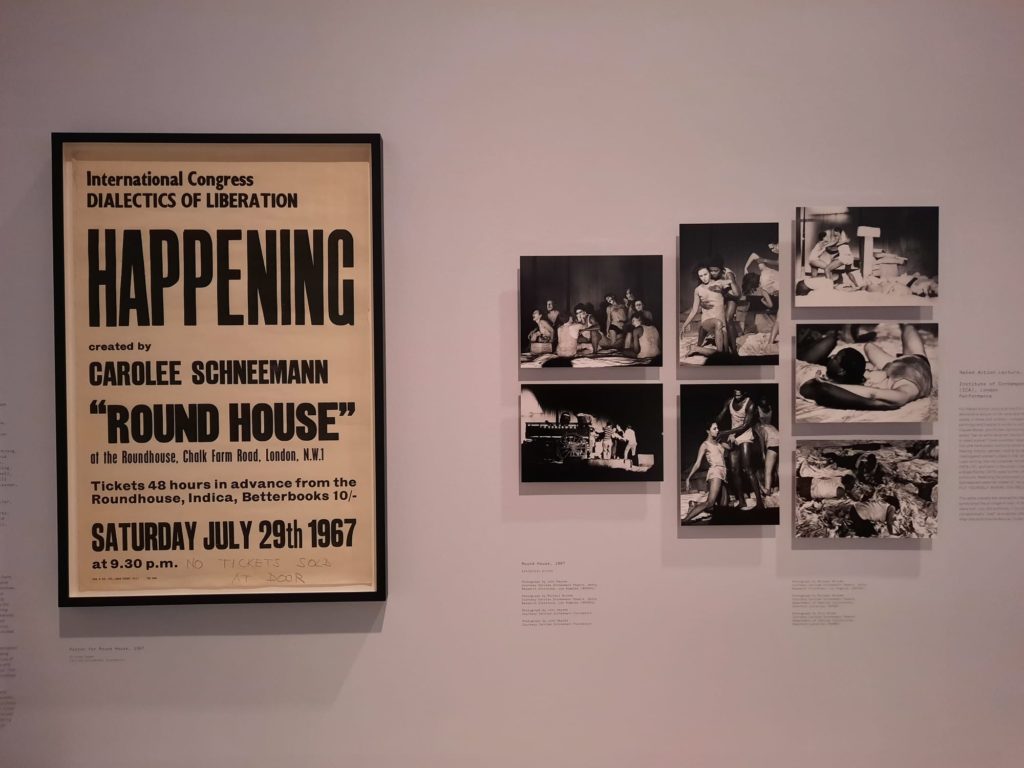
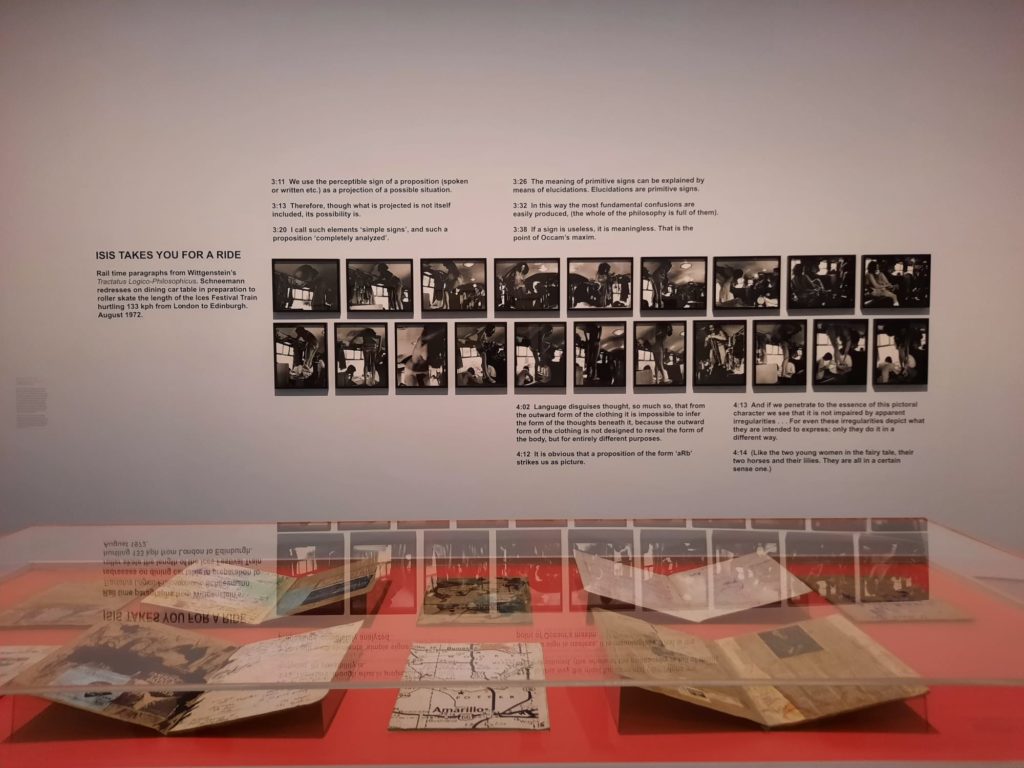
Capturing Performance Art
Because of the interesting subjects the Barbican chooses, a reasonably frequent question which much arise is how to present the ephemeral in a gallery space. You can’t really get a bunch of people to recreate Meat Joy daily after all. Even these days that would be risqué and a Health & Safety nightmare. So the question remains: how do you capture performance in a static setting?
I think the Barbican handles this dilemma quite well. In the case of Carolee Schneemann: Body Politics, the answer is a range of methods. Firstly there are plenty of archival materials. Flyers, preparatory drawings and costumes evoke the creative process. Photographs and film record the performances themselves. And in a couple of instances certain elements are recreated in installations. For instance the harness used by Schneemann in Up to and Including her Limits in the 1970s.
Between these various methods and Schneemann’s kinetic works, there is sufficient energy in this exhibition to pay tribute to the artist. Not quite the same as being at a happening, but it feels broader than an exhibition of static artworks alone.
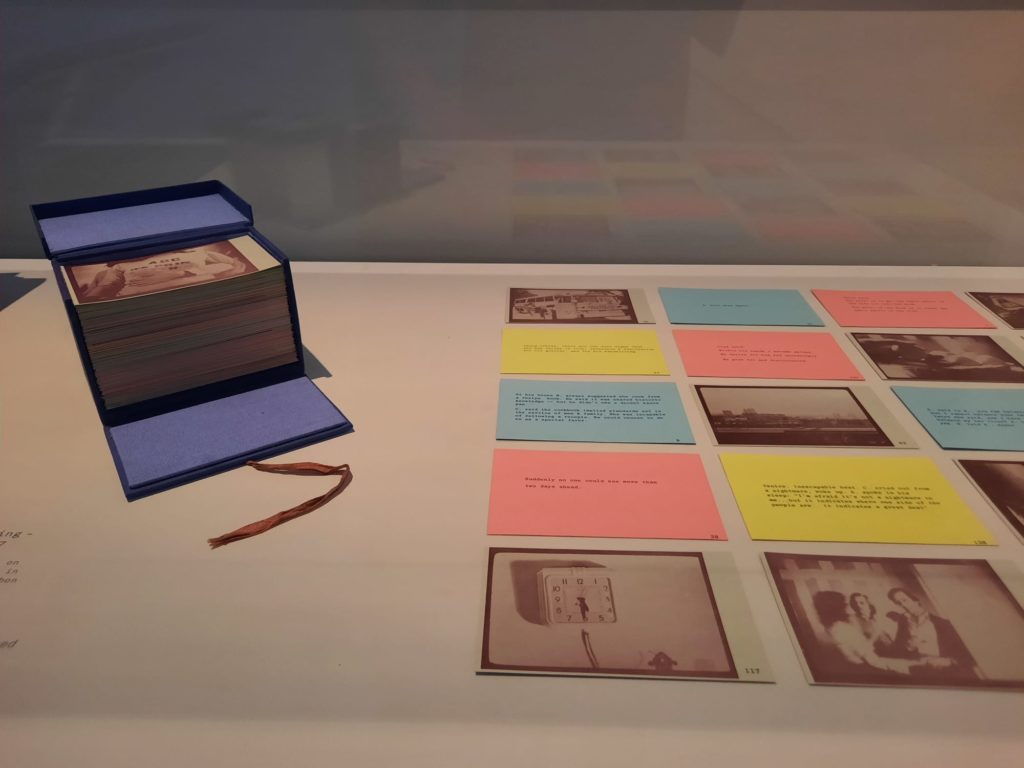
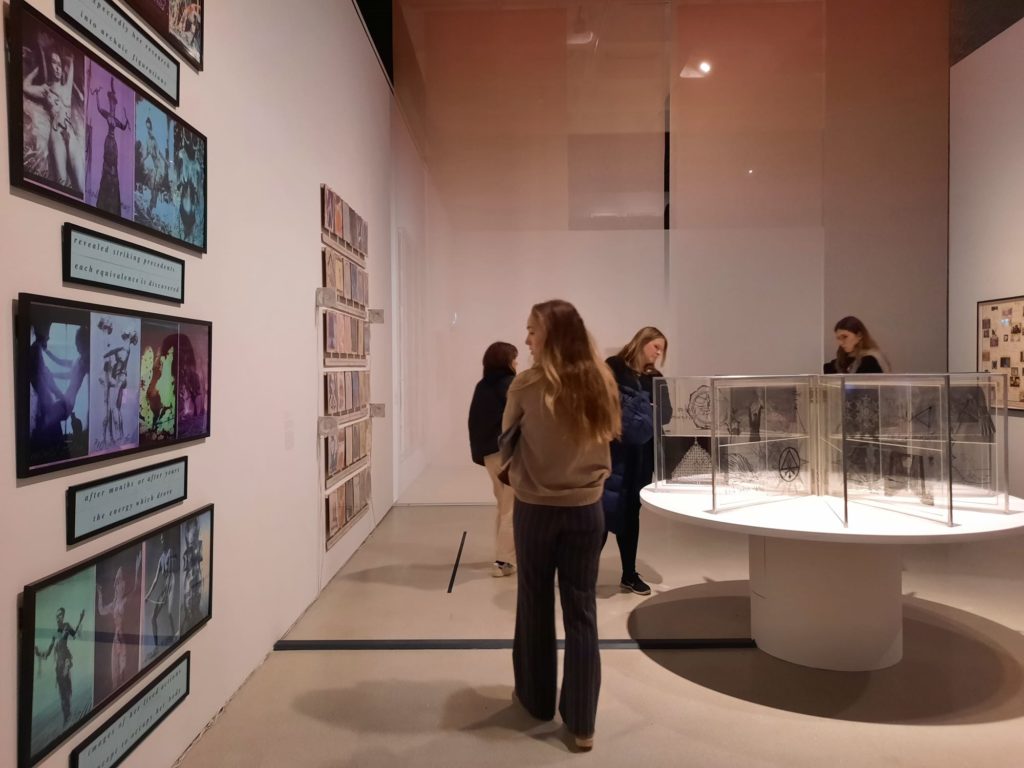
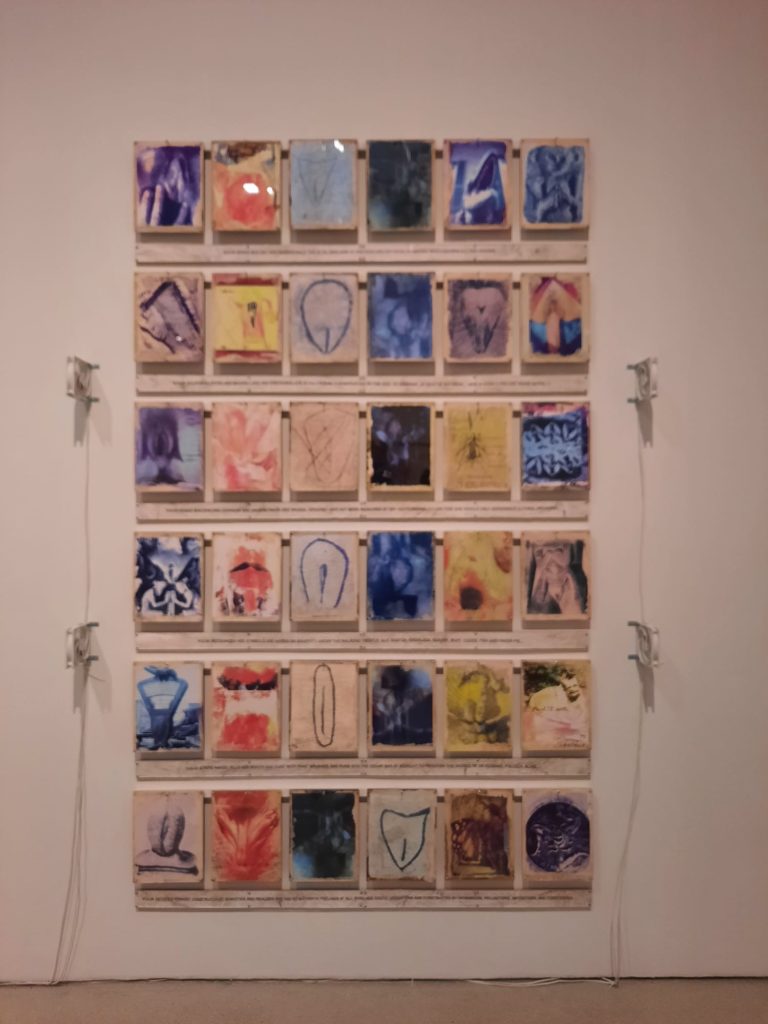
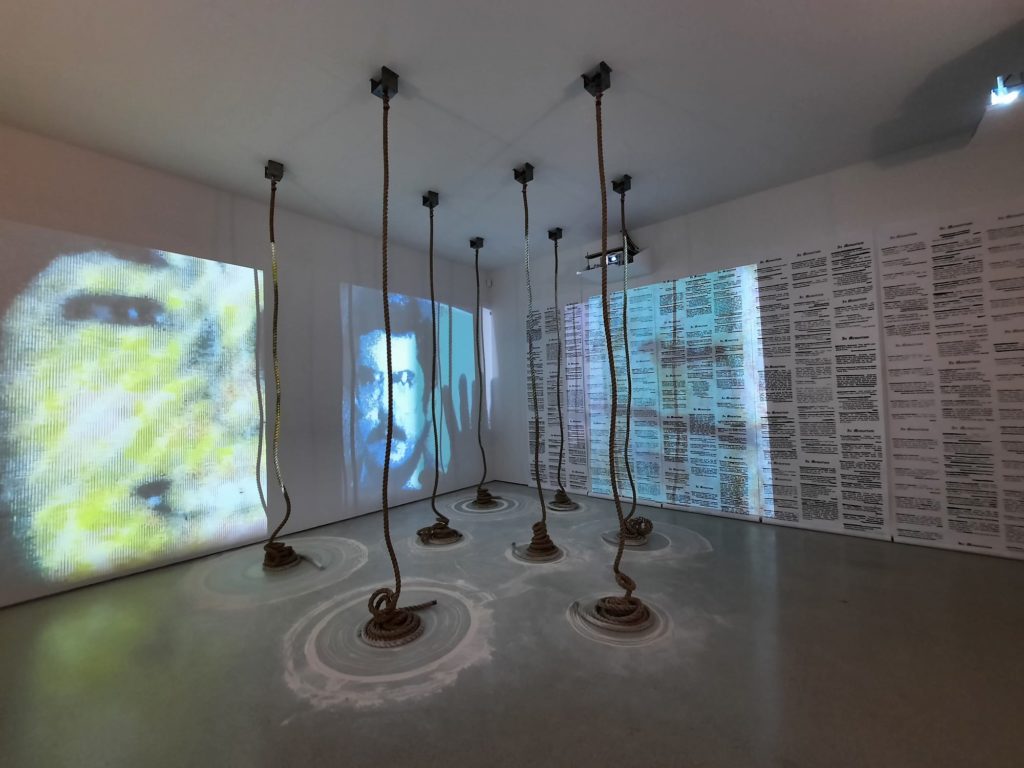
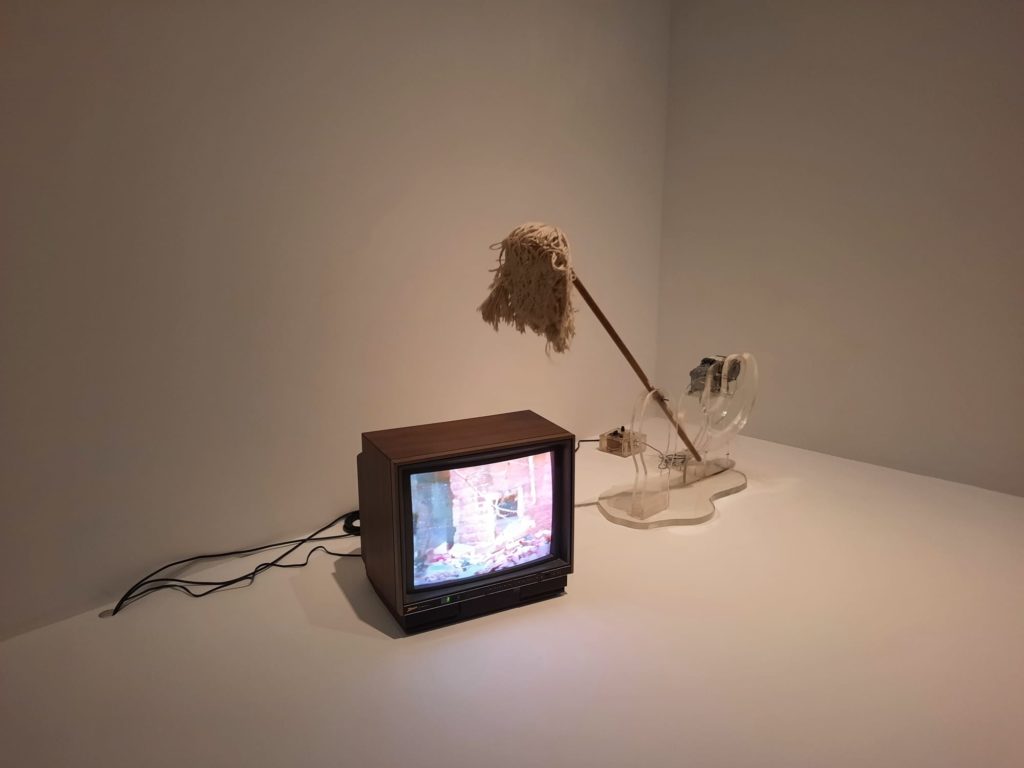
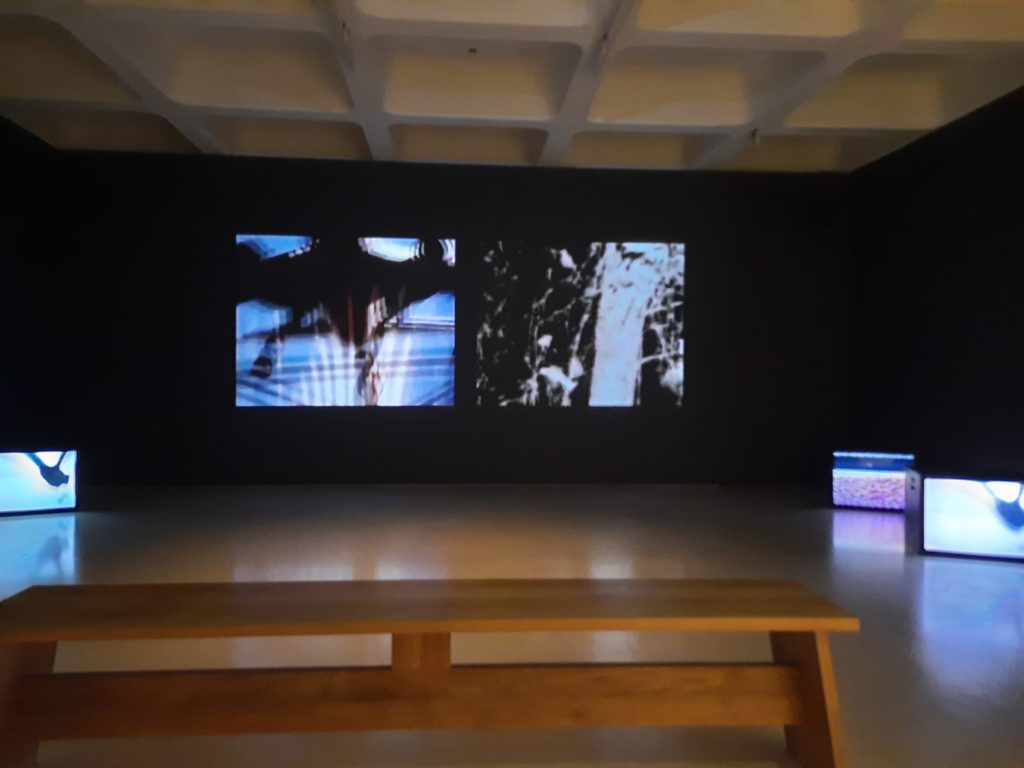
Final Thoughts On Carolee Schneemann: Body Politics
Carolee Schneemann is an artist whose work deserves a moment in the spotlight. Her art is visceral and honest, and many of the issues that concerned her still impact us today. It’s a good case study of art as activism, art as a refutation of and refusal to accept the status quo. The available works and adjacent materials as described above have been carefully mined and curated to build a holistic picture of Schneemann’s art so it’s an unparalleled opportunity to get to know it a little better.
This type of art won’t be for everyone. But I so much enjoy these unexpected and bold Barbican exhibitions as an opportunity to discover a new artist, and thereby a new worldview. By the time I visit a few of these other exhibitions of work by female and feminist artists at the Tate and elsewhere I should have extended my repertoire quite a bit. Filled in a few gaps in my own art historical canon, so to speak!
If you fancy doing the same, Carolee Schneeman: Body Politics is on for a few more weeks at the Barbican. I enjoyed it as a thoughtful and provocative exhibition by an artist who thought far outside the confines of societal and artistic conventions.
Salterton Arts Review’s rating: 3.5/5
Carolee Schneemann: Body Politics on until 8 January 2023
If you see this after your page is loaded completely, leafletJS files are missing.

